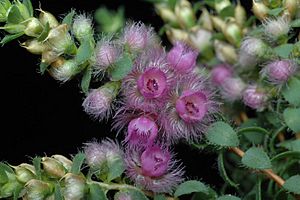Verticordia blepharophylla facts for kids
Quick facts for kids Verticordia blepharophylla |
|
|---|---|
 |
|
| Scientific classification | |
| Genus: |
Verticordia
|
| Species: |
blepharophylla
|
Verticordia blepharophylla is a beautiful flowering plant that belongs to the myrtle family, called Myrtaceae. It's special because it only grows in the south-west part of Western Australia. This plant is an upright, open shrub with a single main stem. It has leaves with tiny hairs along their edges, which look a bit like eyelashes! Its flowers are a lovely pale to deep mauve-pink color. You can find this plant growing in the area between the cities of Perth and Geraldton.
Contents
What Does It Look Like?
Verticordia blepharophylla is an open, bushy shrub that usually has one main stem coming from the ground. It can grow to be about 0.3 to 1.0 meter (about 1 to 3 feet) tall and 0.3 to 1.6 meters (about 1 to 5 feet) wide. Its leaves are shaped like an oval or almost a circle. They are about 2 to 5 millimeters long and have a fringe of hairs up to 1 millimeter long along their edges.
The flowers of this plant have a nice smell. They grow in spikes near the ends of the branches. Each flower sits on a small stalk about 1.0 to 1.5 millimeters long. The floral cup (the base of the flower) is shaped like a top and is about 2.0 to 2.5 millimeters long. It has 5 rounded bumps and a slightly bumpy surface.
The sepals, which are like small leaves that protect the flower bud, are pale to deep mauve-pink. They are about 4.0 to 4.5 millimeters long and have 6 or 7 thread-like fringes. The petals, which are the colorful parts of the flower, are the same color as the sepals and are also about 4.0 to 4.5 millimeters long. They are broadly egg-shaped with a fringe about 1.0 to 1.5 millimeters long. The style, which is part of the female reproductive organ, is S-shaped and about 3.5 to 5 millimeters long. It has a thick beard of hairs about 0.5 millimeters long. This plant usually flowers from late November to February.
How It Got Its Name
The plant Verticordia blepharophylla was first officially described by a scientist named Alex George in 1991. He wrote about it in a science journal called Nuytsia. The plants he studied were collected near Mount Adams by Margaret Pieroni.
Alex George explained that the second part of the plant's name, blepharophylla, comes from two ancient Greek words. Blepharis means "eyelash," and phyllon means "leaf." This name was chosen because the leaves of this plant have tiny hairs along their edges, which look like eyelashes.
Where It Grows
This type of verticordia plant likes to grow in deep sand or in low-lying areas with sandy-clay soil. You can often find it growing with other verticordia species in areas called heathland and shrubland. It is found in the Geraldton Sandplains and Swan Coastal Plain biogeographic regions, specifically between Mount Adams and Hill River.
Looking After This Plant
The Western Australian Government's Department of Parks and Wildlife has classified Verticordia blepharophylla as "not threatened." This means it is not currently in danger of disappearing.
Growing It in Your Garden
This verticordia plant is a good choice for gardens because it can adapt well to different conditions. It produces many bunches of sweet-smelling flowers, sometimes all year round! It can grow in a wide range of soil types. It's also fairly easy to grow new plants from seeds or from cuttings (small pieces of the plant). Often, these new plants will even flower in their very first year.

